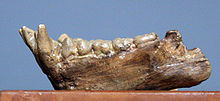Pliopithecus
|
Pliopithecus Temporal range: Miocene |
|
|---|---|
 |
|
| Mandible fragment of Pliopithecus antiquus from Sansan, France; cast from Museum national d'histoire naturelle, Paris | |
| Scientific classification | |
| Kingdom: | Animalia |
| Phylum: | Chordata |
| Class: | Mammalia |
| Order: | Primates |
| Superfamily: | †Pliopithecoidea |
| Family: | †Pliopithecidae |
| Subfamily: | †Pliopithecinae |
| Genus: |
†Pliopithecus Gervais, 1849 |
| Paleospecies | |
Pliopithecus is a genus of extinct primates of the Miocene. It was discovered in 1837 by Édouard Lartet (1801–1871) in France, with fossils subsequently discovered in Switzerland, Slovakia and Spain.
Pliopithecus' had a similar size and form to modern gibbons, to which it may be related, although it is probably not a direct ancestor. It had long limbs, hands, and feet, and may have been able to brachiate, swinging between trees using its arms. Unlike gibbons, it had a short tail, and only partial stereoscopic vision.
They appear to have originated in Asia and extended their range into Europe between 17 and 13 million years ago.
Begun and Harrison list the following species within the genus:
P. antiquus has been referred to previously as P. piveteaui.P. vindobonensis is sometimes considered to be a separate genus, Epipliopithecus.Anapithecus is a close relative and was initially considered a subgenus of Pliopithecus.
...
Wikipedia
